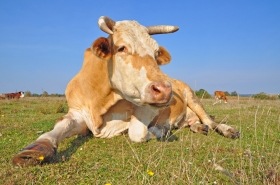Agriculture and Livestock Remain Major Sources of Greenhouse Gas Emissions

Global greenhouse gas emissions from the agricultural sector totaled 4.69 billion tons of carbon dioxide (CO2) equivalent in 2010 (the most recent year for which data are available), an increase of 13 percent over 1990 emissions. By comparison, global CO2 emissions from transport totaled 6.76 billion tons that year, and emissions from electricity and heat production reached 12.48 billion tons, according to Worldwatch Institute’s Vital Signs Online service.
Growth in agricultural production between 1990 and 2010 outpaced growth in emissions by a factor of 1.6, demonstrating increased energy efficiency in the agriculture sector.
The three most common gases emitted in agriculture are nitrous oxide, CO2, and methane. Methane is generally produced when organic materials—such as crops, livestock feed, or manure—decompose anaerobically (without oxygen). Methane accounts for around 50 percent of total agricultural emissions. Enteric fermentation—the digestion of organic materials by livestock—is the largest source of methane emissions and of agricultural emissions overall.
Nitrous oxide is a by-product generated by the microbial breakdown of nitrogen in soils and manures. Nitrous oxide production is particularly high in cases where the nitrogen available in soils exceeds that required by plants to grow, which often occurs when nitrogen-rich synthetic fertilizers are applied. Nitrous oxide is responsible for around 36 percent of agricultural greenhouse gas emissions.
Finally, carbon dioxide is released from soils when organic matter
decomposes aerobically (with oxygen). The largest source of CO2
emissions within agriculture is the drainage and cultivation of "organic
soils"—soils in wetlands, peatlands, bogs, or fens with high organic
material. When these areas are drained for cultivation, organic matter
within the soil decomposes at a rapid rate, releasing CO2. This process
accounts for around 14 percent of total agricultural greenhouse gas
emissions.
Emissions from enteric fermentation rose by 7.6 percent worldwide
between 1990 and 2010, but regional variation was high. At 51.4 percent
and 28.1 percent, respectively, Africa and Asia saw their emissions
increase, while emissions in Europe and Oceania fell by 48.1 percent and
16.1 percent. Europe's significant reduction in emissions parallels the
decline in its beef production between 1990 and 2010, but it may also
reflect increased use of grains and oils in cattle feed instead of
grasses.
"Adding oils or oilseeds to feed can help with digestion and reduce methane emissions. But a shift from a grass-based to a grain- and oilseeds-based diet often accompanies a shift from pastures to concentrated feedlots, which has a range of negative consequences such as water pollution and high fossil fuel consumption," said Laura Reynolds, Worldwatch Food and Agriculture Researcher and the study's author. "Aside from reducing livestock populations overall, there is no other clear pathway to climate-friendly meat production from livestock."
Continue Reading at Worldwatch.org
Cow via Shutterstock
©2013. Copyright Environmental News Network To subscribe or visit go to: http://www.enn.com